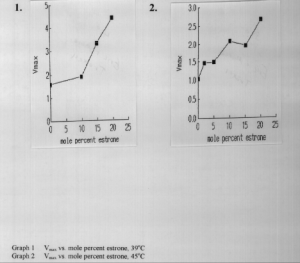Eric M. Troxell, Marci L. Troxell, Drs. Marci L. Troxell and John D. Bell, Zoology
Phospholipase A is a protein that interacts reversibly with the phospholipid bilayer of cell membranes. This interaction is affected by physical alterations in the bilayer, which can be caused by a variety of sources, including temperature and certain drugs. Cholesterol is one of the sources known to change the physical properties of the bilayer. It was hypothesized that estrone (Cl8H2202), which is similar in structure to cholesterol, would also affect the bilayer. Studying the effects of various drugs on the bilayer and phospholipase A2 can lead to greater understanding of the lipid/protein interactions occurring in cells.
Phospholipase A2 hydrolyzes phospholipid, yielding fatty acid and lysolecithin. There is a characteristic lag time during which this reaction is slow, followed by a burst of activity. Studying the length of lag time and rate of hydrolysis are ways to determine whether a drug is influencing the interaction of the bilayer with phospholipase A2.
Artificial phospholipid vesicles were composed of dipalmitoylphosphatidylcholine (DPPC) and used as models of cell membranes. Phospholipase A2 was suspended in a diluent containing NaN3, Kcl, and H20. Estrone was dissolved in methanol and allowed to interact with DPPC and phospholipase A2. Using a fluorometer, the length of the lag time was studied at various temperatures and estrone concentrations. The results were erratic and no sound conclusions could be drawn.
Estrone was dissolved in chloroform and incorporated directly into the bilayer in differing concentrations. The rate of hydrolysis and the lag time were monitored by a pH-stat. Vmax, the maximum velocity of a reaction at a saturated concentration of substrate, was determined for differing concentrations of estrone. The results indicate that estrone does increase the rate of hydrolysis by phospholipase A2. As shown by the graphs, Vmax increases as mole percent estrone increases (Graph 1,2).
References
- Thomas E. Creighton. (1984). “Proteins, Structures and Molecular Principles.” W.H. Freeman and Company, New York 406-412.

